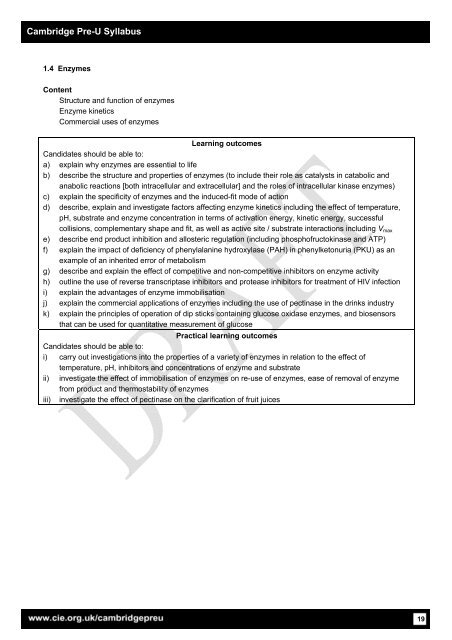Cambridge Pre-U Syllabus - Cambridge International Examinations
Cambridge Pre-U Syllabus - Cambridge International Examinations
Cambridge Pre-U Syllabus - Cambridge International Examinations
Create successful ePaper yourself
Turn your PDF publications into a flip-book with our unique Google optimized e-Paper software.
<strong>Cambridge</strong> <strong>Pre</strong>-U <strong>Syllabus</strong><br />
1.4 Enzymes<br />
Content<br />
Structure and function of enzymes<br />
Enzyme kinetics<br />
Commercial uses of enzymes<br />
Learning outcomes<br />
Candidates should be able to:<br />
a) explain why enzymes are essential to life<br />
b) describe the structure and properties of enzymes (to include their role as catalysts in catabolic and<br />
anabolic reactions [both intracellular and extracellular] and the roles of intracellular kinase enzymes)<br />
c) explain the specificity of enzymes and the induced-fit mode of action<br />
d) describe, explain and investigate factors affecting enzyme kinetics including the effect of temperature,<br />
pH, substrate and enzyme concentration in terms of activation energy, kinetic energy, successful<br />
collisions, complementary shape and fit, as well as active site / substrate interactions including Vmax<br />
e) describe end product inhibition and allosteric regulation (including phosphofructokinase and ATP)<br />
f) explain the impact of deficiency of phenylalanine hydroxylase (PAH) in phenylketonuria (PKU) as an<br />
example of an inherited error of metabolism<br />
g) describe and explain the effect of competitive and non-competitive inhibitors on enzyme activity<br />
h) outline the use of reverse transcriptase inhibitors and protease inhibitors for treatment of HIV infection<br />
i) explain the advantages of enzyme immobilisation<br />
j) explain the commercial applications of enzymes including the use of pectinase in the drinks industry<br />
k) explain the principles of operation of dip sticks containing glucose oxidase enzymes, and biosensors<br />
that can be used for quantitative measurement of glucose<br />
Practical learning outcomes<br />
Candidates should be able to:<br />
i) carry out investigations into the properties of a variety of enzymes in relation to the effect of<br />
temperature, pH, inhibitors and concentrations of enzyme and substrate<br />
ii) investigate the effect of immobilisation of enzymes on re-use of enzymes, ease of removal of enzyme<br />
from product and thermostability of enzymes<br />
iii) investigate the effect of pectinase on the clarification of fruit juices<br />
19

















